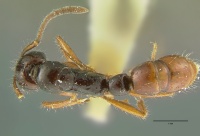Myopias media
| Myopias media | |
|---|---|

| |
| Scientific classification | |
| Kingdom: | Animalia |
| Phylum: | Arthropoda |
| Class: | Insecta |
| Order: | Hymenoptera |
| Family: | Formicidae |
| Subfamily: | Ponerinae |
| Tribe: | Ponerini |
| Genus: | Myopias |
| Species: | M. media |
| Binomial name | |
| Myopias media Willey & Brown, 1983 | |
The holotype, the only known specimen of this species, is a stray collected from rotten wood in a Papua New Guinea montane rain forest.
Identification
Willey and Brown (1983) - Worker: member of tenuis group, very similar to Myopias julivora in habitus, color, etc., but larger, head wider, with more robust and more strongly curved mandibles, the submedian tooth situated closer to the midlength (at the seventh twelfth from base along MLO). Antennae long; scapes overreaching posterior border of head (when held straight back) by nearly twice their apical width.
Keys including this Species
Distribution
Latitudinal Distribution Pattern
Latitudinal Range: -5.333° to -6.416922°.
| North Temperate |
North Subtropical |
Tropical | South Subtropical |
South Temperate |
- Source: AntMaps
Distribution based on Regional Taxon Lists
Indo-Australian Region: New Guinea (type locality).
Distribution based on AntMaps
Distribution based on AntWeb specimens
Check data from AntWeb
Countries Occupied
| Number of countries occupied by this species based on AntWiki Regional Taxon Lists. In general, fewer countries occupied indicates a narrower range, while more countries indicates a more widespread species. |

|
Estimated Abundance
| Relative abundance based on number of AntMaps records per species (this species within the purple bar). Fewer records (to the left) indicates a less abundant/encountered species while more records (to the right) indicates more abundant/encountered species. |

|
Biology
Castes
Nomenclature
The following information is derived from Barry Bolton's Online Catalogue of the Ants of the World.
- media. Myopias media Willey & Brown, 1983: 257, figs. 6, 23 (w.) NEW GUINEA (Papua New Guinea).
- Type-material: holotype worker.
- Type-locality: Papua New Guinea: Huon Peninsula, Mongi River watershed, Joangeng, ca 1500 m., 7-8.iv.1955, no. 752 (E.O. Wilson).
- Type-depository: MCZC.
- Status as species: Bolton, 1995b: 269; Probst, Guénard & Boudinot, 2015: 205 (in key).
- Distribution: Papua New Guinea.
Unless otherwise noted the text for the remainder of this section is reported from the publication that includes the original description.
We describe this species with some misgiving because it is based on a unique, and because it is so similar to Myopias julivora, especially to the largest (Baiyer River) specimen of the lattter. The mandibles, however, differ enough that we feel inclusion of the big Joangeng specimen in M. julivora would unduly strain the concept of that species. Further collections will of course help to demonstrate whether our decision is correct or not. The name media refers to the size of the body, intermediate in the tenuis group between Myopias tenuis and such large forms as Myopias loriai; and Myopias gigas.
Description
Worker
Holotype: TL 7.6, HL 1.25, HW 1.24 (CI 99), ML 0.93 (MI 74), MLO 1.26, SL 1.27 (SI 102), EL 0.13, WL 2.20, hind femur L 1.40, hind tibia L 1.35 mm.
Details additional to diagnosis: Viewed at apparent full-face, posterior border of head feebly convex, almost straight, but even a slight tilting of the cranium forward yields a concave border, and an increase in HL to 1.30, so that from this view, CI would be about 95. Anterolateral corners of head more prominent (at a lower level of focus), so that, excluding eyes, head is widest just behind clypeus. Median frontal sulcus continuing past mid-HL to include anterior clypeal pit. Eyes as in M. julivora, but relatively a little larger, and with remnants of faceting a bit more evident. Median clypeal lobe very obviously broader than long (CLL 0.13, CL W 0.20), with weakly concave sides, nearly straight apical margin, and one free corner rounded, the other rectangular. Mandibles thicker, particularly in the stretch between the obsolescent basal angle and the submedian tooth, which is also feebly convex mesally (concave or straight along mesal margin in M. julivora). Labrum toothed as in M. julivora.
Sculpture as in M. julivora, but small, widely spaced punctures (diameter 0.01-0.02 mm) are perhaps more distinct on head and trunk. A small patch of longitudinal costulation lies below spiracle on side of propodeum (as in M. julivora). Posterior corners of propodeum less broadly rounded, tending more towards angularity, both in side and dorsal views, than in M. julivora, and both the pilosity and pubescence seem to be less copious and a trifle longer. Color deep brownish red; legs yellowish red; antennae and mandibles dark yellowish brown.
Type Material
Holotype and only known specimen (Museum of Comparative Zoology) a stray collected from rotten wood at Joangeng, a villagein the Mongi River Watershed of the Huon Peninsula, Papua New Guinea, at about 1500 m, 7-8 April 1955, in montane rain forest, leg. Wilson, No. 752.
References
References based on Global Ant Biodiversity Informatics
- Janda M., G. D. Alpert, M. L. Borowiec, E. P. Economo, P. Klimes, E. Sarnat, and S. O. Shattuck. 2011. Cheklist of ants described and recorded from New Guinea and associated islands. Available on http://www.newguineants.org/. Accessed on 24th Feb. 2011.
- Willey R. B.; W. L., Jr Brown. 1983. New species of the ant genus Myopias (Hymenoptera: Formicidae: Ponerinae). Psyche (Cambridge) 90: 249-285.
- Wilson Edward O. 1959. Adaptive Shift and Dispersal in a Tropical Ant Fauna. Evolution 13(1): 122-144

